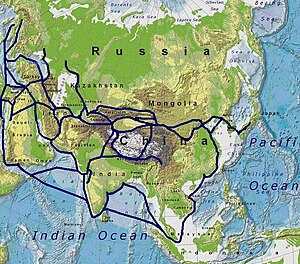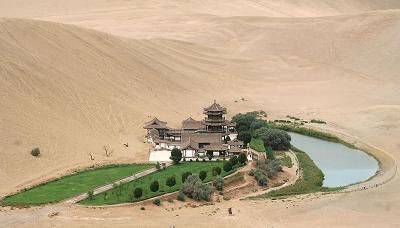Topic 2.1 The Silk Roads
Revision as of 16:06, 29 November 2020 by Jhenderson (talk | contribs) (Created page with "::*'''The Silk Roads''' File:Silkroutes.jpg|right|thumb|Note the Silk Roads connected every classical civilization. Source: http://commons.wikimedia.org/wiki/File:Silkroute...")
- The Silk Roads
 Note the Silk Roads connected every classical civilization. Source: http://commons.wikimedia.org/wiki/File:Silkroutes.jpgThe Silk Roads were made up of an indirect chain of separate transactions through which goods crossed the entire land area of Eurasia. Rarely did merchants themselves travel the length of these routes; in fact, few of them knew the complexity and breadth of the Silk Roads. Merchants primarily engaged in local instances of "relay trade" in which goods changed "hands many times before reaching their final destinations."[1] Because the Silk Roads crossed land it was much more expensive and dangerous to move goods. Consequently, trade focused on luxury items that would bring a nice profit making the greater risks worthwhile. Particularly important were luxury items with a high value to weight ratio.
Note the Silk Roads connected every classical civilization. Source: http://commons.wikimedia.org/wiki/File:Silkroutes.jpgThe Silk Roads were made up of an indirect chain of separate transactions through which goods crossed the entire land area of Eurasia. Rarely did merchants themselves travel the length of these routes; in fact, few of them knew the complexity and breadth of the Silk Roads. Merchants primarily engaged in local instances of "relay trade" in which goods changed "hands many times before reaching their final destinations."[1] Because the Silk Roads crossed land it was much more expensive and dangerous to move goods. Consequently, trade focused on luxury items that would bring a nice profit making the greater risks worthwhile. Particularly important were luxury items with a high value to weight ratio. The Jade Gate. Trade between China and the central Asian nomads took place at this passage in the Great Wall. Photo Credit: John Hill
The Jade Gate. Trade between China and the central Asian nomads took place at this passage in the Great Wall. Photo Credit: John Hill
- The Silk Roads had their origins in Asia as nomadic and settled people exchanged goods. In part, it began because of environmental conditions. The soil in China lacks selenium, a deficiency that contributes to muscular weakness, low fertility, and reduced growth in horses.[2] Consequently, Chinese-raised horses were too frail to support a mounted soldier rendering the Chinese military weak in the face of the powerful cavalries of the steppe nomads. [3] Chinese emperors needed the superior horses that pastoral nomads bred on the steppes, and nomads desired things only agricultural societies could produce, such as grain, alcohol and silk. Even after the construction of the Great Wall, nomads gathered at the gates of the wall to exchange items. Soldiers sent to guard the wall were often paid in bolts of silk which they traded with the nomads.[4] Silk was so wide spread it eventually became a currency of exchange in Central Asia.
- Silk and luxury goods were not the only things that moved across the Silk Roads. Merchants became agents of cultural diffusion. The oasis towns that connected segments of trade became nodes of cultural exchange, especially Buddhism. Mahayana Buddhism spread rapidly, leap-frogging from oasis town to oasis town. The process was facilitated by these towns which often built beautiful Buddhist temples to attract Buddhist merchants abroad. Nestorian Christianity also spread across the Silk Roads into China. Not surprisingly, silk took on a sacred meaning in Buddhist and Christian rituals. Merchants also carried disease. The disease epidemics that devastated the classical civilizations were spread across large ecological zones via the Silk Roads.
- The volume of trade increased dramatically as the classical empires formed. The Romans, Gupta, and Han were centers of production and huge markets for goods. Moreover, the laws and legal systems of these empires provided security for merchants, encouraging them to take more risks. As always, the primary items of trade were luxury goods, and nomadic people continued to play an important role; their movements sometimes served as important connections between segments of trade, buying in one place and selling in another. Some nomads became settled people and made their living off of trade. Nevertheless, the volume of trade on the Silk Roads was connected to the strength of the classical civilizations during this period and declined when they fell into ruin.
- The Silk Roads
- ↑ Ways of the World: A Global History, (2009), Robert W. Strayer, p. 219.
- ↑ Selenium in the Environment, (1994), W.T. Frankenberger (ed.), p. 30.
- ↑ City of Heavenly Tranquility: Beijing in the History of China, (2008), Jasper Becker, p. 18.
- ↑ The Silk Roads: A Brief History with Documents, (2012), Xinru Liu, p. 6.
